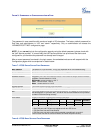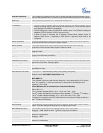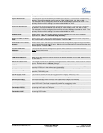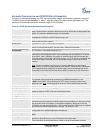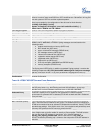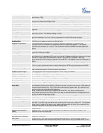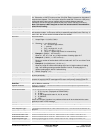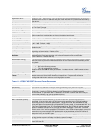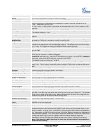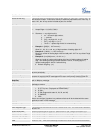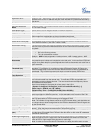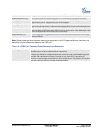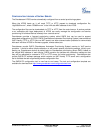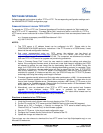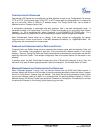
Authenticate Password
SIP service subscriber’s account password.
Name
SIP service subscriber’s name for Caller ID display.
Use DNS SRV
Default is “No.” If set to “Yes” the client will use DNS SRV to look up the server.
User ID is Phone Number
If the HT503 has an assigned PSTN telephone number, this field should be set to
“Yes”. Otherwise, set it to “No”.
If “Yes” is set, a “user=phone” parameter will be attached to the “From” header in SIP
request.
SIP Registration
Controls whether the HT503 needs to send REGISTER messages to the proxy server.
The default setting is “Yes.”
Unregister on Reboot
Default is No. If set to Yes, the SIP user’s registration information will be cleared on
reboot.
Outgoing Call Without
Registration
Default is No. If set to “Yes,” user can place outgoing calls even when not registered (if
allowed by ITSP) but is unable to receive incoming calls.
Register Expiration
This parameter allows the user to specify the time frequency (in minutes) the HT503
refreshes its registration with the specified registrar. The default interval is 60 minutes
(or 1 hour). The maximum interval is 65535 minutes (about 45 days).
Local SIP Port
Defines the local SIP port the HT503 will listen and transmit. The default value for FXS
port is 5062.
Local RTP Port
Defines the local RTP-RTCP port pair the HT503 will listen and transmit. It is the base
RTP port for channel 0. When configured,
channel 0 uses this port _value for RTP and the port_value+1 for its RTCP; channel 1
uses port_value+2 for RTP and port_value+3 for its RTCP.
The default value for FXS port 1 is 5012.
Use Random Port
This parameter forces the random generation of both the local SIP and RTP ports when
set to Yes. This is usually necessary when multiple HT503 units are behind the same
NAT.
Refer to Use Target
Contact
Default is NO. If set to YES, then for Attended Transfer, the “Refer-To” header uses the
transferred target’s contact header information.
DTMF Payload Type
Sends DTMF using RFC2833
DTMF in Audio
Sends DTMF as inband (in-audio).
DTMF via RFC2833
Sends DTMF via RTP (according the RFC2833).
DTMF via SIP INFO
Send DTMF as a SIP INFO message.
Send Flash Event
Default is No. If set to “Yes”, flash will be sent as DTMF event
Enable Call Features
Default is Yes. Toggles support for advanced call features and star code functions.
Proxy Require
SIP Extension to notify SIP server that the unit is behind a NAT/Firewall.
Use NAT IP
NAT IP address used in SIP/SDP message. Default is blank.
Distinctive Ring Tone
Customizes Ring Tones 1 to 3 with an associated Caller ID. When selected, the device
will ONLY use this ring tone when the incoming call is set up for Caller ID. The System
Ring Tone is used for all other calls. When selected with no Caller ID configured, the
selected ring tone will be used for all incoming calls.
Disable Call Waiting
Turns off the Call Waiting feature. Default is No.
Disable Call Waiting
Tone
Default is No. This is to disable the stutter Call Waiting Tone during a CWC. The
CWCID will still be displayed.
Ring Timeout
Sets the time in which an incoming call will stop ringing when not picked up.
Early Dial
Default is No. Use only if proxy supports 484 response. This parameter controls
whether the phone will send an early INVITE each time a key is pressed when a user
dials a number. If set to “Yes”, an INVITE is sent using the dial-number collected thus
far. Otherwise, no INVITE is sent until the “(Re-)Dial” button is pressed or after about 5
seconds have elapsed. The “Yes” option should be used ONLY if there is a SIP proxy
configured and the proxy server supports 484 Incomplete Address response.
Otherwise, the call will likely be rejected by the proxy (with a 404 Not Found error).
Note: This feature is NOT designed to work with and should NOT be enabled for
direct IP-to-IP calling.
Grandstream Networks, Inc. HT503 User Manual Page 27 of 35
Firmware 1.0.0.6 Last Updated: 6/2007



